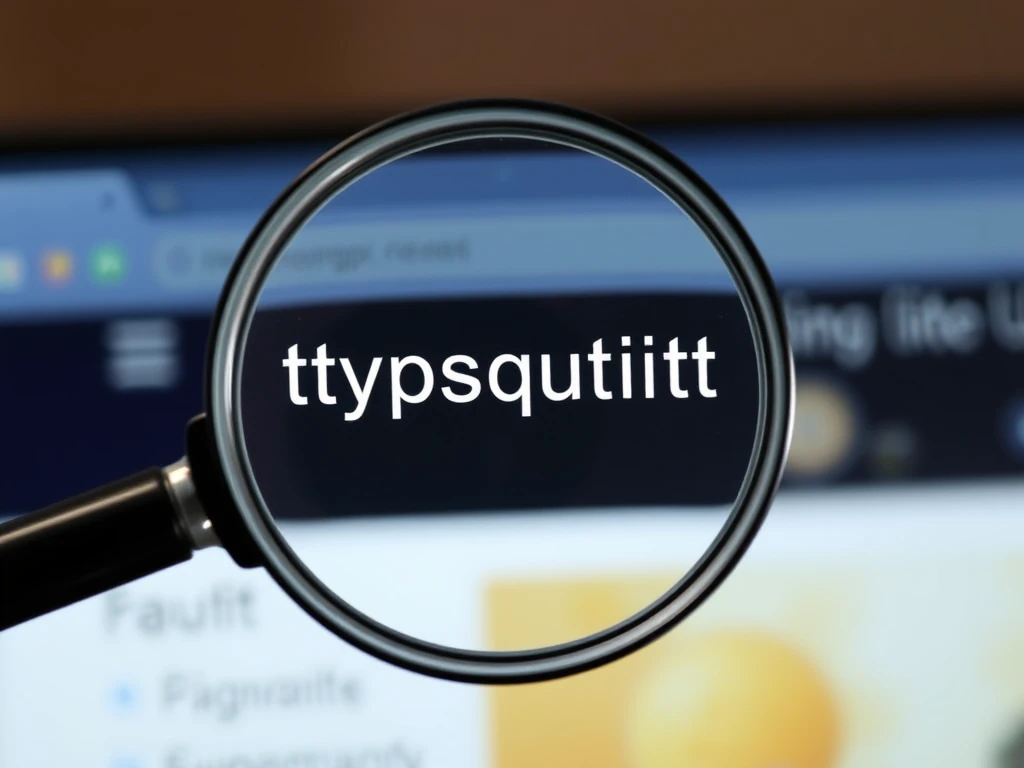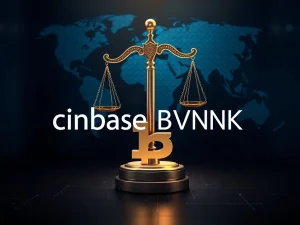GUARD Your Crypto: The SHOCKING Reality of Typosquatting and Domain Mimicry

In the fast-paced world of cryptocurrency, where fortunes can be made and lost in a blink, a silent menace lurks: typosquatting crypto. Imagine a single mistyped letter leading you straight into the hands of cybercriminals. Sounds unbelievable? Unfortunately, it’s a stark reality. This deceptive tactic, also known as domain mimicry or URL hijacking, is a growing threat, and understanding it is your first line of defense in maintaining robust crypto security. Let’s dive deep into how these digital tricksters exploit our everyday typos and, more importantly, how you can shield yourself from falling victim to these sophisticated crypto scams.
Decoding Typosquatting in Crypto: How Domain Mimicry Works
Ever rushed to type a website address and made a tiny error? Typosquatting preys on these common mistakes. Cybercriminals register domain names that are incredibly similar to popular crypto platforms – think slight misspellings, added characters, or swapped letters. For instance, instead of coinbase.com, you might accidentally type coinbsae.com. This seemingly minor slip can land you on a fake website meticulously crafted to steal your sensitive information. This is domain mimicry at its most deceptive.
These counterfeit sites are designed to look and feel just like the real deal. They might prompt you to enter your private keys, recovery phrases, or login details. Unsuspecting users, believing they are on a legitimate platform, unknowingly hand over the keys to their digital kingdom. The consequences can be devastating – stolen funds, compromised personal data, and a harsh lesson in online vigilance. The pseudonymous nature of crypto transactions makes recovering stolen funds incredibly difficult, making typosquatting crypto a particularly nasty form of attack.
Remember the 2019 Europol investigation? It uncovered a massive 24-million-euro cryptocurrency theft orchestrated through typosquatting. Cybercriminals created fake exchange sites, mimicking legitimate platforms, and stole login details from over 4,000 victims across 12 countries. This real-world example underscores the severity and scale of these crypto scams.
The Mechanics of a Typosquatting Attack: Exploiting URL Hijacking
How exactly do these attackers pull off URL hijacking and domain mimicry? Let’s break down the mechanics:
- Domain Registration Deception: Cybercriminals are meticulous in their approach. They register domains that are just a hair’s breadth away from legitimate crypto platforms. Think of replacing an ‘o’ with a ‘0’, adding an extra letter, or swapping adjacent characters. For example, bitcoiin.com instead of bitcoin.com. These subtle alterations easily slip past a hurried glance. A study even revealed scams exploiting Blockchain Naming Systems (BNS) with similar domain names, leading to significant financial losses.
- Phishing and Malware Distribution: Typosquatting crypto isn’t just about fake websites. Attackers often use these deceptive domains to launch phishing attacks. They might send emails or messages that appear to be from the real platform, directing you to their fake site to ‘verify your account’ or ‘claim rewards.’ These sites can also be vehicles for malware. By clicking a seemingly innocent link or downloading ‘software,’ you could unknowingly install malicious programs that compromise your device and steal your crypto assets.
- Deceptive Website Duplicates: The fake websites themselves are often masterful copies of the real thing. Attackers invest time in replicating the design, user interface, and even the branding of legitimate platforms. The goal? To create a seamless illusion. When you land on these sites, everything looks familiar, lulling you into a false sense of security. This is where the danger lies – inputting your sensitive information on what you believe is a trusted site, only to realize too late it was a cleverly disguised trap.
Common Targets: Wallets, Tokens, and Websites in Crypto Ecosystem
Typosquatting crypto attacks aren’t random. Cybercriminals strategically target specific areas within the cryptocurrency ecosystem:
- Wallets: Wallet addresses are prime targets. Attackers create addresses that look almost identical to legitimate ones, changing just a character or two. When sending crypto, a quick copy-paste without careful verification could lead you to send funds to a fraudulent address. For example, a legitimate Ethereum address like 0xAbCdEf1234567890… might be mimicked by 0xAbCdEf1234567891… – a difference easily missed.
- Tokens: Fake tokens are another lucrative avenue for scammers. They create counterfeit tokens with names and symbols nearly identical to popular, legitimate tokens. Unwary investors, caught up in the hype, might purchase these fake tokens, believing they are investing in the real deal. Imagine seeing a token called “UniSwap Classic” – it looks legitimate, but it could be a complete scam.
- Websites: As discussed, websites are the primary battleground for typosquatting crypto. These fraudulent sites, with their near-identical domain names, are designed for phishing attacks, credential theft, and malware distribution. Examples like myetherwallett.com (with two ‘t’s) instead of myetherwallet.com highlight how subtle these deceptions can be.
The Ripple Effect: How Typosquatting Impacts Developers and Users
The impact of typosquatting crypto is far-reaching, affecting both developers and users in significant ways.
Impact on Cryptocurrency Developers: Reputational and Financial Damage
For developers, typosquatting crypto poses a serious threat to their hard work and reputation:
- Reputational Damage: When users fall victim to crypto scams through typosquatted domains, they might mistakenly blame the legitimate service. Negative experiences on fake platforms can tarnish the reputation of the original project, even though they are not at fault. This erosion of trust can be incredibly damaging in the long run.
- Financial Harm: Attackers can siphon off funds intended for legitimate services by intercepting users through typosquatted domains. This diversion of revenue directly impacts developers, hindering project growth and development. The cumulative financial losses from typosquatting crypto can be substantial, potentially derailing promising projects.
Remember the SEC allegations against fake crypto exchanges NanoBit and CoinW6? They reportedly stole $3.2 million by building trust on social media and then exploiting typosquatting tactics. This case underscores the serious financial and legal repercussions of crypto scams facilitated by domain mimicry.
Impact on Cryptocurrency Users: Financial Loss, Data Theft, and Malware
Users are on the front lines of the battle against typosquatting crypto, facing a range of potential harms:
- Financial Losses: The most direct impact is financial loss. Users who inadvertently interact with fraudulent sites due to typos can lose funds directly by sending crypto to scam addresses or by having their wallets compromised. Exploiting typos in BNS systems alone has resulted in users being tricked into sending cryptocurrency to attackers, causing significant financial damage.
- Theft of Sensitive Information: Fake websites are designed to trick users into divulging sensitive information like private keys and recovery phrases. Once attackers gain access to this information, they can empty wallets and control user accounts, leading to devastating financial consequences.
- Malware Infections: Typosquatting crypto sites can be breeding grounds for malware. Visiting these sites can lead to device infections, opening the door to a cascade of security breaches. Malware can steal personal data, cause further financial losses, and even turn your device into a tool for wider cyberattacks.
Cybersquatting vs. Typosquatting: Knowing the Difference
While both cybersquatting and typosquatting crypto involve deceptive domain registrations, their intent and execution differ. Cybersquatting is like digital land-grabbing. Cybercriminals register domains related to well-known crypto projects or exchanges, often hoping to sell them back to the rightful owners for a profit. For example, registering EthereumExchange.com before Ethereum launches its official exchange, hoping for a lucrative sale later.
Typosquatting crypto, on the other hand, is more predatory. Attackers create domains with minor spelling variations of legitimate crypto platforms specifically to trick users into visiting fake sites. The aim is direct deception – stealing credentials, deploying malware, or redirecting funds. Think of registering Binannce.com (double ‘n’) to mimic Binance and steal user logins. The table below summarizes the key differences:
| Feature | Cybersquatting | Typosquatting |
|---|---|---|
| Intent | Profit from domain resale | Directly deceive users for immediate gain (theft, malware) |
| Domain Similarity | Resembles brand name, often generic terms | Very close spelling variations of legitimate domains |
| Primary Goal | Domain resale | Steal credentials, deploy malware, redirect funds |
Legal Challenges: Navigating the Murky Waters of Typosquatting in Crypto
The legal landscape surrounding typosquatting crypto is complex and often frustrating. Here’s a glimpse into the legal headaches:
- Proving Intent vs. Infringement: Trademark infringement laws exist, but proving “intent to deceive” in typosquatting crypto cases is tricky. Did the typosquatter intend to mislead, or was it a “harmless” mistake? In the anonymous world of crypto, demonstrating malicious intent can be like chasing shadows.
- Jurisdictional Nightmares: Crypto’s borderless nature clashes with traditional legal systems. When a scammer in one country targets users across the globe through typosquatting, which laws apply? Where do you even begin legal action? This creates a web of international legal challenges, making enforcement incredibly difficult.
- Evolving Definition of “Consumer Harm”: Consumer protection laws are struggling to keep pace with the unique risks of crypto. Losing private keys due to a typosquatting crypto scam isn’t the same as buying a faulty product. Courts are grappling with redefining “consumer harm” in the digital age, leading to legal gray areas.
- UDRP Limitations: The Uniform Domain-Name Dispute-Resolution Policy (UDRP) is often used for domain disputes. However, its effectiveness in typosquatting crypto is limited. Crypto projects might lack formal trademarks, which are often needed for successful UDRP claims, leaving them vulnerable.
- Smart Contract Exploits: Typosquatting crypto can even lead to smart contract exploits. Scammers might direct users to malicious smart contracts designed to steal funds. This adds another layer of complexity, raising questions about the legal status of smart contracts and their use as evidence in court.
- Criminal Liability and Money Laundering: Beyond civil suits, typosquatting crypto can lead to criminal charges, especially when combined with money laundering. Funneling stolen crypto through fake sites can trigger serious legal repercussions, as law enforcement increasingly tracks these digital trails.
Defense Strategies: How to Detect and Prevent Typosquatting
Combating typosquatting crypto requires a proactive approach from both developers and users. Here’s how to strengthen your defenses:
For Developers: Proactive Domain Security and User Protection
- Domain Monitoring: Regularly scan for new domain registrations that resemble your brand or service. Early detection is key to taking swift action against potential typosquatting crypto attempts.
- Secure Similar Domains: Proactively register common misspellings and variations of your domain name. Owning these variations allows you to redirect traffic to your official site, preventing fraudulent sites from gaining traction and enhancing your domain security.
For Users: Become a Digital Detective and Enhance Crypto Security
- User Education is Power: Educate yourself and others about the risks of typosquatting crypto. Vigilance is your best defense. Learn to recognize official websites and be wary of subtle domain name variations.
- Implement Security Features: Look for Secure Sockets Layer (SSL) certificates (the padlock icon in your browser), trust seals, and always double-check the URL. Bookmarking frequently visited crypto sites minimizes the risk of typos. These measures significantly improve your crypto security.
Collaboration is Key: Working Together to Combat Crypto Scams
- Collaborate with Authorities: Developers and users should work with domain registrars, law enforcement, and regulatory bodies to report and address typosquatting crypto incidents. Collective action can lead to the removal of fraudulent domains and the prosecution of offenders, strengthening the overall crypto security ecosystem.
Reporting Crypto Crime: Taking Action Against Typosquatting
If you suspect you’ve been a victim of typosquatting crypto, reporting the crime is crucial. Here’s a general guide and specific resources for the US, UK, and Australia:
General Steps for Reporting Typosquatting Crypto Crime:
- Report to the Domain Registrar: Contact the registrar where the fraudulent domain is registered. Most registrars have clear abuse reporting procedures.
- Seek Legal Counsel (for complex cases): For complex or international cases, consult a lawyer specializing in cybercrime and intellectual property law.
- Inform Crypto Platforms: If funds were sent to a fraudulent wallet, notify the relevant cryptocurrency exchange or wallet provider.
- Document Transactions: Use blockchain explorers to document transactions to fraudulent addresses – this provides valuable evidence.
Reporting in the US, UK, and Australia:
- United States:
- General Cybercrime: Internet Crime Complaint Center (IC3) – partnership between the FBI and the National White Collar Crime Center.
- Trademark Issues: United States Patent and Trademark Office (USPTO).
- Domain Name Disputes: ICANN’s Uniform Domain-Name Dispute-Resolution Policy (UDRP).
- United Kingdom:
- General Fraud: Action Fraud, the national reporting center.
- Trademark Infringements: UK Intellectual Property Office (IPO).
- Domain Name Disputes: ICANN’s Uniform Domain-Name Dispute-Resolution Policy (UDRP).
- Australia:
- Cyber Incidents: Australian Cyber Security Centre (ACSC).
- Cybercrimes: ReportCyber.
- Domain Name Disputes: ICANN’s Uniform Domain-Name Dispute-Resolution Policy (UDRP).
Conclusion: Vigilance is Your Best Weapon Against Typosquatting Crypto
Typosquatting crypto remains a persistent and evolving threat in the cryptocurrency world. It underscores the critical need for vigilance from both developers and users. By understanding the mechanics of these attacks, implementing preventative measures, and reporting suspicious activity, we can collectively strengthen crypto security and create a safer digital currency ecosystem. Stay informed, stay vigilant, and protect your crypto assets!







